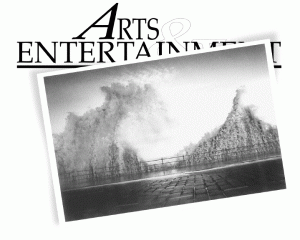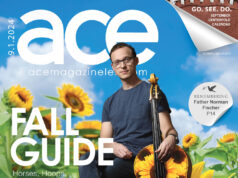P I C T U R E
T H I S…
Lecture series brings international photographer to UK
By Kara Fitzgerald
 Michael Kenna has virtually perfected the art of night photography, taking you to places you never knew existed and finding unexpected beauty in the ordinary and everyday subjects
Michael Kenna has virtually perfected the art of night photography, taking you to places you never knew existed and finding unexpected beauty in the ordinary and everyday subjects
As a photographer, Kenna has explored the world’s landscapes from industrial textile mills to French gardens. He’s captured nature in all its glory-yes, even his nuclear power plants appear harmless as their dangerous emissions are elegantly captured in a cloud-like formation, something only Kenna could pull off successfully. Such photographs could be considered straightforward social commentary, although that is not the intention, for Kenna admits that he enjoys leaving a huge question mark on each print, which adds an element of intrigue to his work. His frozen images reflect a mixture of gloom and mystery…the obscure come to life through his point of view.
“I’ve always liked the landscape and I like to walk in the landscape, and my work is about, broadly speaking, the relationship and juxtaposition and confrontation between landscapes and organic matters and the structures that we place in and around the landscape. So, I have photographs of the natural landscape, but I also have photographs of nuclear power stations, steel work, and industrial subject matter from the north of England,” says Kenna, “I have certain reactions to nuclear power stations and other industrial matters, but I’m not imposing my judgment on anybody else. I’m presenting evidence of what is out there, but I do leave you with a large question mark. I would much prefer it if individual viewers would make their own conclusions.”
Kenna plans on discussing such issues when he visits UK’s Art Museum on April 17 for the first annual Robert C. May Photography Endowment Lecture Series, which was initiated last fall and has since featured artists Richard Benson, Emmet Gowin, and Duane Michals. This series pays homage to photography by featuring international photographers, photography historians, and other notable speakers in the field. Kenna was invited not only because of his international status, but also because of the contributions he has made to the field of photography.
“It’s one of our most exciting initiatives that we’ve been able to have in recent years because it gives us an opportunity to excel in a particular area, in this case photography, and not only through acquisitions, but through the lecture series and related photography issues,” says Harriet Fowler, director of UK’s Art Museum, “We wouldn’t have the means to bring speakers such as Michael Kenna to the museum on an ongoing basis without this wonderful fund. We’re really excited about it and are trying to draw in people, students, and photographers from the whole region.”
“As part of our educational mission, we want to broaden the opportunities available for both the university community and the community at large and given the success of the previous lectures of the very first year of the series, we are confident that this will grow and prosper; it’s clearly filling a desire of people in this community to know more about photography and to know more about contemporary artists. The appeal lies far beyond photography circles, these are very wide ranging talks and we leave it up to the photographers themselves to come up with what they most want to talk about,” says Rachael Sadinsky, curator of UK’s Art Museum.
“I’m going to be showing slides of my work of the last 25 years, so it will be quite biographical; it will cover a good range of subject matter,” says Kenna enthusiastically.
Kenna, who was born in Widnes, Cheshire, England in 1953, received the Friends of Imogene Cunningham Award and the KQED/Zellerbach Award in 1981. He became interested in photography while studying art in London and became a successful commercial photographer, doing book and record jacket pictures, and was the printer for San Francisco photographer Ruth Bernhard in the late 70s. As his artistic work began to sell, Kenna focused on his true passion-the landscape.
“When I go to the theater, before the actors come on stage, I can make up my own story…there’s a degree of anticipation of something about to happen. I like to photograph an empty stage in a way so that not only myself but other viewers of the work can bring their own experience and imagination to create their own storyline. When an actor comes on stage, you’re drawn to their story and you listen to them and are entertained by them, but I would like a more active participation I suppose,” says Kenna in response to why he prefers photographing landscapes rather than people.
“I chose photography because I was always good in art and painting and it seemed to be an ideal medium because it gave me not only a means of self expression, but it also gave me a means of survival because I studied commercial photography also. I was always drawn to graphic design as well as photography…I’m always drawn to geometrics,” says Kenna.
Throughout the years, Kenna began to experiment with night photography and enjoyed shooting during dusk and dawn. He captured images that were both moody and sensual, full of dramatic light and shadows. He is well known for his night photography, which he has now mastered, and still thrives on its excitement.
“We tend to see the world, as photographers, from the single vantage point of a single light source which is the sun, and that light source can be coming through clouds as diffused light or it can be direct, but nevertheless a single source that’s usually above us. When you photograph at night, the light sources can become unpredictable…One never knows during the long exposure exactly what is going to turn up on the film because the film is recording elements that we cannot physically see; it’s recording a series of time, we can only see a fraction of the time,” explains Kenna. “So, for example, if a plane goes by it will leave a certain mark on the film, a track, or if water is moving, we will not see the individual flashing of the individual waves, it will come out as an almost black surface. If cars go by, they will leave their own tracks, if people walk by, the landscape moves. It’s exciting for me to photograph at night because in a sense I don’t have control and I never really know what’s going to happen on the film.”
Kenna is also known for his carefully printed silver-gelatin prints that have a range of tonal values and which enhance their obscure subject matter. An example of Kenna’s work, Wave, demonstrates his ability to capture a moment which almost seems surreal and appears quite powerful.
“Michael Kenna’s photographs are gorgeously printed; they are suggestive of an inherent mystery. His landscapes are ambiguous. We are only given scattered clues as to geographical location, or the time of day, or even the year. There is a romantic ethereal spirit to his work,” comments Sadinsky.
Kenna, who teaches at Friends of Photography in San Francisco, is currently finishing up a 10-year project on concentration camps in Europe. It will culminate in the year 2000 with an exhibition, a book , and a tour. He plans on going to Poland to continue photographing.
“I think everyone can benefit [from the lecture]. When you think about it, photography is certainly one of the most democratic of all art media because everybody can pick up a camera and snap pictures…they understand it, they aren’t afraid of it, and when you see what master photographers can do with the art itself, which goes way beyond a record or document, then I think it can be pretty inspiring to the rest of us,” says Fowler.
Michael Kenna will be speaking on April 17 at 4 p.m. in the University Art Museum’s Main Gallery. The lecture and exhibition are free and open to the public. For more information, call 257-5716.








